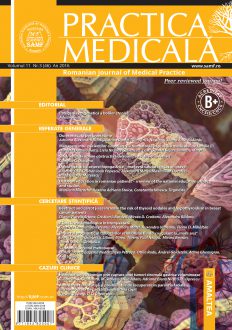SELECT ISSUE

Indexed

| |

|
|
|
| |
|
|
|

|
|
|
|
|
|
|
HIGHLIGHTS
National Awards “Science and Research”
NEW! RJMP has announced the annually National Award for "Science and Research" for the best scientific articles published throughout the year in the official journal.
Read the Recommendations for the Conduct, Reporting, Editing, and Publication of Scholarly work in Medical Journals.
The published medical research literature is a global public good. Medical journal editors have a social responsibility to promote global health by publishing, whenever possible, research that furthers health worldwide.
Syncronous medullar thyroid cancer and primary hyperparathyroidism on a female within the sixth decade of life with positive family history for type 2A MEN syndrome
Ana VALEA, Otilia RADU, Andra MORAR, Adina GHEMIGIAN and Mara CARSOTE
ABSTRACT
Medullar thyroid cancer (MTC) may be sporadic or familial, either linked with pheocromocytoma (PHEO) and primary hyperparathyrodism (PHP), as seen in type 2A MEN (Multiple Endocrine Neoplasia) syndrome, either isolated.
This is a 56-year old female known with mild arterial hypertension controlled under therapy, having a daughter with type 2A MEN syndrome (PHEO, MTC, PHP). Mild hypercalcemia and high parathormone
were consistent for PHP, while calcitonin was 20 times above the upper normal limit for MTC. The PHEO tests were negative. Anterior cervical ultrasound confirmed a 2.7 cm thyroid nodule, local lymph nodes, and enlargement of inferior and superior left prarathyroids. After total thyroidectomy with bilateral neck dissection and excision of the left inferior and superior parathyroid glands, MTC and parathyroid hyperplasia was confirmed. Calcitonin decreased to 5 times above the normal level. Further close follow-up and therapy of residual MTC is needed.
MEN 2A Syndrome may embrace various clinical presentations with more or less aggressive tumours, sometimes allowing a long time survival without neoplasia confirmation or incomplete phenotype until advanced age.
Keywords: medullar thyroid cancer, primary hyperparathyroidism, MEN syndrome
Full text | PDF

